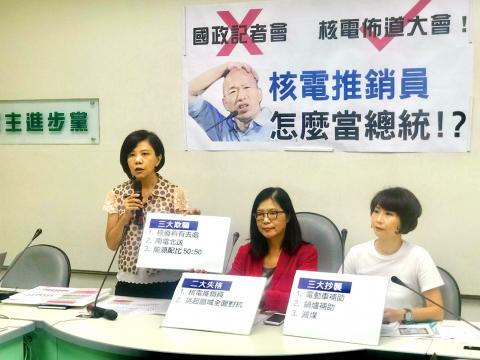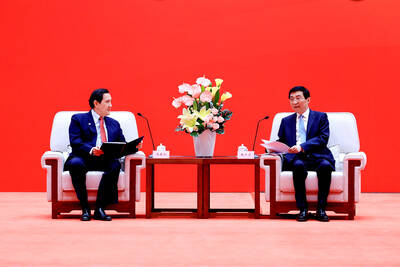Restarting work on the Fourth Nuclear Power Plant and deferring decommissioning of the Guosheng plant in New Taipei City’s Wanli District (萬里) and Ma-anshan plant in Pingtung County’s Ma-anshan (馬鞍山) would pose technical difficulties, so plans to do so are infeasible, Executive Yuan spokeswoman Kolas Yotaka said yesterday in response to a proposal by Kaohsiung Mayor Han Kuo-yu (韓國瑜).
The Ministry of Economic Affairs has said on numerous occasions that Taiwan would not face an energy shortage in the run-up to 2030, Kolas told a news conference in Taipei after a Cabinet meeting.
State-owned Taiwan Power Co (Taipower, 台電) in January said it plans to invest more than NT$400 billion (US$12.75 billion) to develop sources of renewable energy over the next 15 years, with the aim of expanding the nation’s total installed offshore wind power capacity to 180 megawatts and total installed solar power capacity to 100 megawatts by 2030.

Photo: Peng Wan-hsin, Taipei Times
The government is dedicated to developing sources of renewable energy, with those currently installed allowing the nation to retain an operating reserve of 10 percent last month, despite peak summer demand for electricity, an unprecedented feat, she said.
The Executive Yuan reiterated that it is the government’s job to ensure a clean and stable supply of energy while maintaining public safety, she said.
Democratic Progressive Party (DPP) lawmakers denounced an energy policy proposed by the advisory team of Han’s, the Chinese Nationalist Party’s (KMT) presidential candidate, calling it “deceptive.”
DPP Legislator Kuan Bi-ling (管碧玲) said that she was frightened by Han’s promise to restart work at the mothballed Fourth Nuclear Power Plant and the shortsightedness of former premier Simon Chang (張善政), who is head of Han’s advisory team.
The plant in New Taipei City’s Gongliao District (貢寮) was officially mothballed in July 2015 during then-president Ma Ying-jeou’s (馬英九) administration, while state-run Taipower last year started transporting unused fuel rods from the plant to the US.
The policy proposed by Han and Chang became an “evangelical meeting” to promote nuclear power, Kuan said.
While the DPP administration plans to generate 20 percent of the nation’s power from renewable sources by 2025, Han’s team’s proposal to generate 50 percent of total energy from renewable sources sounds unrealistic and needs more explanation, DPP Legislator Yeh Yi-jin (葉宜津) said.
Han’s team must clarify whether it wants to build additional nuclear power plants, Yeh said.
Separately, President Tsai Ing-wen (蔡英文) said Han should do more homework before commenting on energy policy, adding that New Taipei City Mayor Hou You-yi’s (侯友宜) concerns over nuclear waste and his hesitation to resume construction of the mothballed plant is more practical.
Taiwan does not face power shortages, she said, adding that any proposals to restart work on the plant need to answer the question about how to tackle nuclear waste.
Policy explanation requires pragmatic efforts over time, which should not be outsourced to an advisory team that actually comprises members from the previous KMT administration, Tsai said.

LONG FLIGHT: The jets would be flown by US pilots, with Taiwanese copilots in the two-seat F-16D variant to help familiarize them with the aircraft, the source said The US is expected to fly 10 Lockheed Martin F-16C/D Block 70/72 jets to Taiwan over the coming months to fulfill a long-awaited order of 66 aircraft, a defense official said yesterday. Word that the first batch of the jets would be delivered soon was welcome news to Taiwan, which has become concerned about delays in the delivery of US arms amid rising military tensions with China. Speaking on condition of anonymity, the official said the initial tranche of the nation’s F-16s are rolling off assembly lines in the US and would be flown under their own power to Taiwan by way

CHIP WAR: The new restrictions are expected to cut off China’s access to Taiwan’s technologies, materials and equipment essential to building AI semiconductors Taiwan has blacklisted Huawei Technologies Co (華為) and Semiconductor Manufacturing International Corp (SMIC, 中芯), dealing another major blow to the two companies spearheading China’s efforts to develop cutting-edge artificial intelligence (AI) chip technologies. The Ministry of Economic Affairs’ International Trade Administration has included Huawei, SMIC and several of their subsidiaries in an update of its so-called strategic high-tech commodities entity list, the latest version on its Web site showed on Saturday. It did not publicly announce the change. Other entities on the list include organizations such as the Taliban and al-Qaeda, as well as companies in China, Iran and elsewhere. Local companies need

CRITICISM: It is generally accepted that the Straits Forum is a CCP ‘united front’ platform, and anyone attending should maintain Taiwan’s dignity, the council said The Mainland Affairs Council (MAC) yesterday said it deeply regrets that former president Ma Ying-jeou (馬英九) echoed the Chinese Communist Party’s (CCP) “one China” principle and “united front” tactics by telling the Straits Forum that Taiwanese yearn for both sides of the Taiwan Strait to move toward “peace” and “integration.” The 17th annual Straits Forum yesterday opened in Xiamen, China, and while the Chinese Nationalist Party’s (KMT) local government heads were absent for the first time in 17 years, Ma attended the forum as “former KMT chairperson” and met with Chinese People’s Political Consultative Conference Chairman Wang Huning (王滬寧). Wang

OBJECTS AT SEA: Satellites with synthetic-aperture radar could aid in the detection of small Chinese boats attempting to illegally enter Taiwan, the space agency head said Taiwan aims to send the nation’s first low Earth orbit (LEO) satellite into space in 2027, while the first Formosat-8 and Formosat-9 spacecraft are to be launched in October and 2028 respectively, the National Science and Technology Council said yesterday. The council laid out its space development plan in a report reviewed by members of the legislature’s Education and Culture Committee. Six LEO satellites would be produced in the initial phase, with the first one, the B5G-1A, scheduled to be launched in 2027, the council said in the report. Regarding the second satellite, the B5G-1B, the government plans to work with private contractors